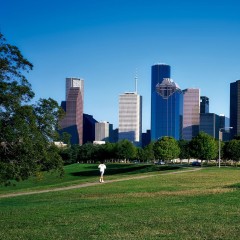This post is part of a series highlighting the findings from the 2023 Kinder Houston Area Survey.
As it happened, the banner headline on the front page of the Houston Chronicle that day read: “Pfizer vaccine approved for kids 12-15,” a reference to one of the available vaccines against COVID-19. A page inside the paper was devoted entirely to news about the coronavirus. National coverage was similarly heavy. The words “covid” and “pandemic” rang incessantly in the minds of people in the Houston area and across the country.
COVID-19 didn’t rate a mention on the Chronicle’s front page of May 11, 2022. And that year, the share of Houston Area Survey respondents rating public health as the city’s biggest problem fell to 15%. This year, the share dropped to 2% — close to the level in most years prior to 2020, when the pandemic was emerging and the public was gradually becoming aware of its seriousness. That year, 4% of survey respondents cited public health as the area’s biggest problem.
“Public health,” of course, is a broad term that has reflected many health-related concerns over the years, including high costs or limited access to medical care.
"There’s a lot of stuff that gets lumped into that general heading,” explained Dan Potter, the Kinder Institute’s senior director of research.
Still, it’s clear that concerns about public health over the past three years have waxed and waned in response to the real or perceived status of the COVID-19 pandemic. The virus is still out there — 77,294 new cases, 1,109 deaths and 1,360 hospitalizations were reported by the federal Centers for Disease Control and Prevention from March to May of this year. But the COVID-inspired public health emergency expired this month. And the new survey results indicate that concern about COVID-19 has reverted to pre-pandemic levels, raising questions about whether the public has become complacent about a lingering threat.
Potter compared the recent public health findings to a similar trend after Hurricane Harvey struck the Houston area in August 2017. When the 2018 survey was conducted a few months later, “a lot of Houstonians were looking around and felt that the biggest problems were flooding, climate, extreme weather. How do we create a city that’s resilient to that? We had all just lived through an amazing experience. By 2019-2020, that line had settled back down,” as Harvey receded in the public consciousness even though flooding risks had not been eliminated.
With regard to COVID-19 – as a proxy for the broader category of public health – a similar pattern emerged, Potter said. As time went on, “we were getting vaccinated, going back to work, mask mandates were gone. It’s an out-of-sight, out-of-mind situation.”
Dr. Peter Hotez, the co-director of Texas Children’s Hospital’s Center for Vaccine Development and dean of the National School of Tropical Medicine at Baylor College of Medicine, offered a similar assessment of the survey findings on the subject of public health.
“It says to me that people are concerned about what’s in front of their nose at the current moment,” said Hotez, who has been a leading national voice calling for vigilance and pushing back against disinformation regarding the pandemic. “People have short memories.”
My own experience fits with Hotez’s thesis. When the pandemic emerged in the spring of 2020, I checked all the high-risk boxes: I was 65 years old, suffered from chronic illness, and, as a liver transplant recipient, took anti-rejection drugs that weakened my immune system. I was among the first in line for every available vaccine and booster, and for much of 2020 I lived in virtual quarantine, ordering food deliveries and greeting occasional visitors on my patio or in my garage with the door open. Later, as I gradually resumed going to public places, I never failed to don a mask. These days, I rarely dip into my mask stash and live much as I did before I had ever heard of COVID-19. I’ve been lucky; I’ve never had the virus, as far as I know, and although most of my friends and family have been infected, none has become seriously ill or died.
What was once a firehose of pandemic news coverage has slowed to a steady trickle, but Hotez says other factors help to explain the ebbing concern reflected in the new survey findings.
“I would say that the local news and radio stations have worked really hard to get the message out,” said Hotez. “I think I must have been on local TV almost every day during the pandemic. It’s not like the media’s at fault in any way. I think people are just quick to tune out unless they see that a threat is imminent.”
Beyond the risks of complacency about COVID-19, Hotez says it’s vital that public leaders and health agencies prepare for future pandemics, including new versions of coronaviruses.
“I’m predicting another major pandemic before the end of this decade,” he said. “The (COVID-19) pandemic revealed deficits in the ability of the CDC to respond. They were not good about issuing information about the effectiveness of vaccines. Under new leadership, it’s better, but it’s still a work in progress.”
Potter, the Kinder research director, said the drop in the share of survey respondents citing public health as the area’s greatest problem probably doesn’t reflect attitudes about preparation for future pandemics.
“If you asked, ‘Are we prepared for the next health crisis?’, it wouldn’t surprise me if you got a generally pessimistic response,” he said.
Mike Snyder is a Houston-based journalist who worked for 40 years as a reporter, editor and columnist at the Houston Chronicle.


